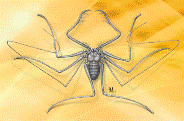Papers in the Biological Sciences

Eileen Hebets Publications
Document Type
Article
Date of this Version
4-2020
Citation
Ethology 126:4 (April 2020), pp. 403–412.
doi: 10.1111/eth.12985
Abstract
Many arthropods are known to be sensitive to the geomagnetic field and exploit the field to solve spatial problems. The polarity of the geomagnetic field is used, for instance, as an orientation cue by leafcutter ants as they travel on engineered trails in a rainforest and by Drosophila larvae as they move short distances in search of food. A ubiquitous orientation cue like the geomagnetic field may be especially useful in complex, cluttered environments like rainforests, where the reliability of celestial cues used to navigate in more open environments may be poor. The neotropical amblypygid Paraphrynus laevifrons is a nocturnal arachnid that wanders nightly in the vicinity of its shelter and occasionally travels 30 m or more in the rainforest understory before it returns to its shelter. Here, we conducted a field experiment to determine whether navigation by P. laevifrons is guided by the ambient magnetic field and a complementary laboratory experiment to assess whether a magnetic anomaly could be used to pinpoint the entrance of a shelter. In the field experiment, subjects were fitted with a radio transmitter and a small, powerful magnet or a similar-sized brass disk and displaced 10 m from their shelter. The return rate of magnet-fitted subjects was similar to that of brass-fitted subjects and to that of subjects in an earlier study fitted with only a radio transmitter. In the laboratory experiment, we trained P. laevifrons with a protocol under which the amblypygid Phrynus marginemaculatus rapidly learns—in 1–14 trials over two daily sessions—to associate an olfactory stimulus with access to a shelter. The conditioned stimulus here was a magnetic anomaly characterized by a high total field intensity and a 180° reversal of the polarity of the ambient magnetic field. The magnetic anomaly–shelter contingency was not learned in 50 trials conducted over 10 daily sessions. These results imply prima facie that P. laevifrons does not rely on a magnetic compass to locate or recognize a shelter and, perhaps, that the magnetic field cannot be detected, but alternative explanations are discussed.
Included in
Animal Sciences Commons, Behavior and Ethology Commons, Biology Commons, Entomology Commons, Genetics and Genomics Commons


Comments
Copyright © 2019 Blackwell Verlag GmbH. Used by permission.